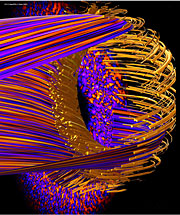- Number 329 |
- January 24, 2011
28 million hours of supercomputing time to advance fusion research

A plasma turbulence simulation.
Scientists seeking to harness fusion energy — a clean, potentially limitless energy source based on the same reaction that powers our sun — need to better understand how hot, super-charged gases called plasmas behave inside fusion reactors. Today's supercomputers may help bring scientists a step closer to that knowledge. To support this effort, the U.S. Department of Energy is awarding 28 million processor hours on its advanced supercomputers to two projects headed by scientists at DOE's Princeton Plasma Physics Laboratory (PPPL).
The PPPL projects are among 57 innovative projects awarded nearly 1.7 billion processing hours on the DOE's advanced supercomputers — the largest total ever — reflecting both the growing sophistication of the field of computer modeling and simulation and the rapid expansion of supercomputing capabilities at DOE National Laboratories in recent years. Awarded under the Department's Innovative and Novel Computational Impact on Theory and Experiment (INCITE) program, many of the new and continuing INCITE projects aim to further renewable energy solutions and understanding of the environmental impacts of energy use.
"The Department of Energy's supercomputers provide an enormous competitive advantage for the United States," said Secretary Chu."This is a great example of how investments in innovation can help lead the way to new industries, new jobs, and new opportunities for America to succeed in the global marketplace."
PPPL's Weixing Wang has been awarded 20 million supercomputing hours on the Jaguar at the DOE Oak Ridge National Laboratory in Tennessee and PPPL's William Tang has been awarded 8 million supercomputing hours on the Intrepid at the DOE Argonne National Laboratory in Illinois. Four additional PPPL scientists — Stephane Ethier, Greg Hammett, Wei-Li Lee, and David Mikkelsen — are involved in PPPL and DOE Lawrence Livermore National Laboratory projects receiving awards. The researchers will be using the time for fusion energy-related research regarding simulations of plasma turbulence at small and large scales. Plasma is a hot gas of charged particles and the fuel for fusion energy production. It makes up most of the visible universe, comprising all the stars in the cosmos.
"The application of modern computation to the grand challenge of understanding turbulence in fusion plasmas offers potential for breakthroughs in our ability to control turbulence. These projects represent the leading edge of this fertile and crucial area," said PPPL Director Stewart Prager.
The Department is awarding time on two of the world's fastest and most powerful supercomputers — the Cray XT5 ("Jaguar") at Oak Ridge and the IBM Blue Gene/P ("Intrepid") at Argonne. Jaguar's computational capacity is roughly equivalent to 109,000 laptops all working together to solve the same problem. Intrepid is roughly equivalent to 26,000 laptops.[Patti Wieser, 609.243.2757,
pwieser@pppl.gov]
